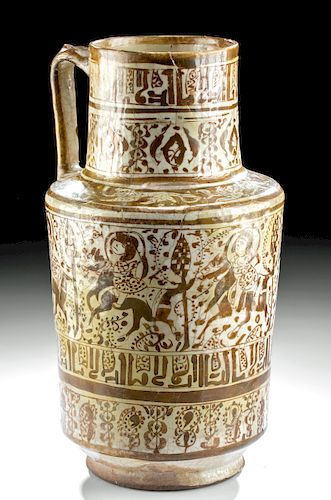Published 12th C. Islamic Lusterware Pitcher, TL Tested
Lot 82
About Seller
Artemis Gallery
686 S Taylor Ave, Ste 106
Louisville, CO 80027
United States
Selling antiquities, ancient and ethnographic art online since 1993, Artemis Gallery specializes in Classical Antiquities (Egyptian, Greek, Roman, Near Eastern), Asian, Pre-Columbian, African / Tribal / Oceanographic art. Our extensive inventory includes pottery, stone, metal, wood, glass and textil...Read more
Categories
Estimate:
$3,500 - $5,000
Absentee vs Live bid
Two ways to bid:
- Leave a max absentee bid and the platform will bid on your behalf up to your maximum bid during the live auction.
- Bid live during the auction and your bids will be submitted real-time to the auctioneer.
Bid Increments
| Price | Bid Increment |
|---|---|
| $0 | $25 |
| $300 | $50 |
| $1,000 | $100 |
| $2,000 | $250 |
| $5,000 | $500 |
| $10,000 | $1,000 |
| $20,000 | $2,500 |
| $50,000 | $5,000 |
| $100,000 | $10,000 |
| $200,000 | $20,000 |
About Auction
By Artemis Gallery
Feb 13, 2020
Set Reminder
2020-02-13 10:00:00
2020-02-13 10:00:00
America/New_York
Bidsquare
Bidsquare : Exceptional Antiquities, Asian, Ethnographic
https://www.bidsquare.com/auctions/artemis-gallery/exceptional-antiquities-asian-ethnographic-4848
An important one-day auction featuring museum-worthy examples of Egyptian, Greek, Roman, Etruscan, Near Eastern, Far East / Asian, Pre-Columbian, African / Tribal, Oceanic, Native American, Spanish Colonial, Russian, Fossils, Ancient Jewelry, Fine Art, so much more! Artemis Gallery info@artemisgallery.com
An important one-day auction featuring museum-worthy examples of Egyptian, Greek, Roman, Etruscan, Near Eastern, Far East / Asian, Pre-Columbian, African / Tribal, Oceanic, Native American, Spanish Colonial, Russian, Fossils, Ancient Jewelry, Fine Art, so much more! Artemis Gallery info@artemisgallery.com
- Lot Description
Western Asia, Iran, Rayy (Rhages), ca. 12th to early 13th century CE. One of my absolute favorites, an elegant lusterware (also lustre ware) pitcher decorated with a gold-on-cream glaze, made in the medieval Persian city of Rayy, known as Rhages to Classical authors. The pitcher is columnar in form, gently widening from its short disc foot to a flanged shoulder. Above the shoulder is a cylindrical spout with a thin, unpronounced rim. A delicate handle attaches just below the rim and at the edge of the shoulder. Highly stylized pseudo-Kufic script rings the neck in two registers, with floral and geometric motifs interspersed. The shoulder features a band of lions who chase each other around its circumference. Size: 4.85" W x 9.25" H (12.3 cm x 23.5 cm)
Below the neck, the body is painted with three registers: a large one, featuring riders on horseback and one person standing just below the handle, probably depicting a hunt; below that is another band of pseudo-Kufic script and one of floral/geometric motifs, mirroring the decoration of the neck. The interior of the mouth also has a ring of Kufic script, some painted directly onto the unglazed ceramic, and some on the trailing cream-colored glaze that has flowed a few centimeters below the rim.
Rayy, once a vast and successful city that fell to the Mongols after thousands of years of occupation, left behind rich remains that have helped us understand the medieval Islamic world. One characteristic of that time period was the combination of beauty and utility, and this pitcher was likely used in a home. Thousands upon thousands of pottery sherds from vessels like this one have been found buried in pits beside medieval homes in Rayy and other Persian cities, where people deposited their kitchenware after they were done with it (there were no medieval garbage collectors!). This tells us that ordinary people - not just the elite and the wealthy - invested in richly decorated vessels like this one.
Published in J. Eisenberg, "Art of the Ancient World VI", 1991, part 2 no. 83
This piece has been tested using thermoluminescence (TL) analysis and has been found to be ancient and of the period stated. A full report will accompany purchase.
Provenance: ex-Royal Athena, New York, USA; acquired from Guy Loudmer, Paris, France, 1988
All items legal to buy/sell under U.S. Statute covering cultural patrimony Code 2600, CHAPTER 14, and are guaranteed to be as described or your money back.
A Certificate of Authenticity will accompany all winning bids.
We ship worldwide and handle all shipping in-house for your convenience.
#151620Repaired from multiple pieces with small areas of overpaint along some of the repair lines. Overall the exterior artwork is beautifully preserved with light wear commensurate with age and fine craquelure on the glaze. Underside has a TL drill hole and two old collection stickers.Condition
- Shipping Info
-
All shipping is handled in-house for your convenience. Your invoice from Artemis Gallery will include shipping calculation instructions. If in doubt, please inquire BEFORE bidding for estimated shipping costs for individual items.
-
- Buyer's Premium



 EUR
EUR CAD
CAD AUD
AUD GBP
GBP MXN
MXN HKD
HKD CNY
CNY MYR
MYR SEK
SEK SGD
SGD CHF
CHF THB
THB















